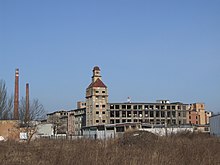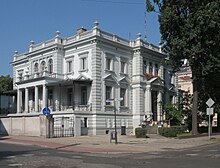Nowa Sól
| Nowa Sól | ||
|---|---|---|

|
|
|
| Basic data | ||
| State : | Poland | |
| Voivodeship : | Lebus | |
| Powiat : | Nowa Sól | |
| Area : | 21.56 km² | |
| Geographic location : | 51 ° 48 ' N , 15 ° 43' E | |
| Height : | 65 m npm | |
| Residents : | 38,763 (Jun. 30, 2019) |
|
| Postal code : | 67-100 to 67-103 | |
| Telephone code : | (+48) 68 | |
| License plate : | FNW | |
| Economy and Transport | ||
| Street : | DK3 Świnoujście - Szczecin ↔ Legnica - Jakuszyce | |
| Rail route : | Wroclaw-Szczecin | |
| Wolsztyn – Żagań | ||
| Next international airport : | Poses | |
| Gmina | ||
| Gminatype: | Borough | |
| Surface: | 21.56 km² | |
| Residents: | 38,763 (Jun. 30, 2019) |
|
| Population density : | 1798 inhabitants / km² | |
| Community number ( GUS ): | 0804011 | |
| Administration (as of 2007) | ||
| Mayor : | Wadim Tyszkiewicz | |
| Address: | ul. Piłsudkiego 12 67-100 Nowa Sól |
|
| Website : | www.nowasol.pl | |
Nowa Sól [ ˈnɔva ˈsul ] ( German Neusalz on the Oder ) is a city in the Polish voivodeship of Lebus . It is the district town of Powiat Nowosolski ( Neusalz an der Oder district ). The formerly independent municipality of Stare Żabno was incorporated into the city in 1961.
Geographical location
The city is located in Lower Silesia on the left bank of the Oder south of the confluence of the Czarna Struga ( Landgraben or Schwartze ), a left tributary of the Oder, about 30 kilometers northwest of Glogau .
history


Under bohemian sovereignty
The first settlement on the area of today's Nowa Sól was under Bohemian rule in the 14th century .
Under the Habsburgs
In 1563 the chamber property Zum Neuen Saltze was built on the old Oder with an important boiling plant . Emperor Ferdinand I wanted to ensure the supply of Silesia with sea salt from La Rochelle and Spain , which was transported via Hamburg and Stettin on the Oder to the end of navigability , and thus curb the import of salt from Poland.
In 1573, after the Oder floods, a new boiler was built near the village of Modritz (Modrzyca). The associated Salzamtmannshaus stood on the site of today's town hall. Around 1585 the place was mentioned for the first time in documents as Neusalzburg and later as Neusalz. To facilitate trade, a port was built on the Oder in 1592. The emergence of Dutch and English competition in the Baltic Sea trade led to difficulties in the supply of crude salt from the end of the 16th century. Salt production became more and more unprofitable. In addition to the salt tariffs of the Electorate of Brandenburg, it was above all the Thirty Years' War that brought the plant down. Later, the boiling plant recovered somewhat, but could no longer hold its own against the salt flats from Brandenburg and Poland . When the Swedes cut off the import of sea salt via Stettin in 1710 , salt production finally ceased. In 1713, the conversion of the former Siedewerks done to Faktorei for salt the salt works in Halle and Magdeburg .
A Protestant church was built in 1597. In 1662 a post office was built.
Under the Hohenzollern
With the preliminary peace of Breslau in 1742, Neusalz became Prussian. On October 8, 1743, the Prussian King Frederick the Great New Salt granted city rights and had a plan drawn up for the further development of the place. The import of rock salt with barges from Stettin to Neusalz and onward transport by land was resumed. This led to a revitalization of the place and the settlement of settlers, u. a. from Moravia . In 1743 800 people lived in Neusalz. The Moravian Brethren received on 13 May 1743 permit the establishment of a colony southeast of the city. Under Ernst Julius von Seydlitz a community center with numerous businesses was established.
On September 24, 1759, after the battle of Kunersdorf, Russian troops invaded Neusalz and plundered and destroyed parts of the city. The Moravian settlement burned down completely. The first factory for linen production was established in Neusalz in 1765. The Brethren's shop was also reopened and later became the Meyerotto freight forwarding, trading and banking house.
Industrialization and the German Empire
In 1816 the textile factory of Johann David Gruschwitz (later JD Gruschwitz & Söhne oHG , from 1906 Gruschwitz Textilwerke AG ), the largest employer in the city for a long time , emerged from the weaving mill of the Brethren . The first ironworks was put into operation in 1827 by the share association Eisenhütte Neusalz . The Paulinenhütte was added in 1853 . In the vicinity of the city between the rivers Czarna Struga and Śląska Ochla ( Ochel ) there was enough lawn iron ore . Above all, the production of enamel dishes became the focus of the smelters and foundries. This gave rise to large export companies that continued to grow between 1877 and 1880 even after all blast furnaces were closed.
The Oderhafen was expanded in 1831. The bristle finishing shop as a supplier for the manufacture of paintbrushes and brushes was established in 1850. In 1870 a wooden bridge was built in place of the Oder ferry, which helped the place to better connect to Poznan . A reinforced concrete bridge was built in its place in 1932.
Neusalz as the northernmost stacking place in Silesia lost much of its importance with the construction of the Lower Silesian-Märkische Railway from Berlin to Breslau from 1846, as the railway passed Neusalz over a large area. It was not until 1871 that the city was connected to the railway network and received a connection to Stettin and Berlin. In 1892 the Meyerotto-Bank took over the glue factory and developed it into an important company. In 1897 the Oder harbor was enlarged again, later a dam system was built on the Oder to prevent severe flood damage such as that of 1592, 1736, 1854 and 1903 in the future. Around 1900 Neusalz had three Protestant churches (one of which belongs to the Herrnhuter parish), a Catholic church, a private progymnasium , an orphanage , a district court and a number of different manufacturing companies and production facilities.
Weimar Republic, Nazi dictatorship and World War II
In 1930 the town in the Freystadt district had 16,500 inhabitants. During the Second World War , a labor camp for Jews and later a branch of the Groß-Rosen concentration camp was established.
The Red Army reached Neusalz on February 14, 1945, after German troops had blown up the Oder Bridge on February 9. The fighting caused major damage in the city.
People's Republic of Poland and Third Republic
In the summer of 1945 Neusalz and almost all of Silesia were placed under Polish administration by the Soviet occupying power and the German population was expelled . The city was developed into an important industrial location in Poland and took over from Kożuchów (Freystadt) as the administrative center of the region in 1950 .
Population development
| year | Residents | Remarks |
|---|---|---|
| 1880 | 9,073 | thereof 6,856 Protestants, 1,897 Catholics and 85 Jews |
| 1905 | 13,022 | thereof 2,926 Catholics and 65 Jews |
| 1925 | 14,166 | thereof 10,957 Protestants, 3,019 Catholics, 19 other Christians and 46 Jews |
| 1933 | 16,463 | thereof 12,515 Evangelicals, 3,282 Catholics, two other Christians and 52 Jews |
| 1939 | 17.113 | thereof 13,192 Evangelicals, 3,358 Catholics, 69 other Christians and nine Jews |
| 2016 | 39,258 | |
| 2018 | 39,098 |
Attractions
- Town hall from the 16th century
- Monument to Friedrich II from the 19th century
- St. Michaelis Church from the 16th century
- Salt storage from the 17th and 18th centuries
- Parish church of St. Antonius by Friedrich August Stüler from the 19th century
- Chapel of the Protestant community from the 19th century
- St. Barbara Church, built in 1900
- Drawbridge at the Oder canal port
Twin cities
- Achim (Verden district) (Germany)
- Fresagrandinaria (Italy)
- Püttlingen (Germany)
- Saint-Michel-sur-Orge (France)
- Senftenberg (Germany)
- Veszprém (Hungary)
- Žamberk (Czech Republic)
Personalities
- Carl Bernhard Garve (1763–1841), Protestant theologian and hymn poet, worked in Neusalz for 21 years
- Johann David Gruschwitz (1776–1848), founder of Gruschwitz Textilwerke AG
- Christian David Gebauer (1777–1831), Danish painter
- Samuel Ludwig Hartig (1790–1868), organ builder
- Hermann Franke (1834–1919), cantor and composer
- Gustav A. Schneebeli (1853–1923), American politician
- Paul Guder (1855–1925), neurologist and coroner, born in Modritz
- Otto Jaekel (1863–1929), geologist and paleontologist
- Robert Kuhnert (1863–1947), agricultural scientist
- Walter Thor (1870–1929), portrait painter
- Erich Siltz (1880–1942), publisher of the Neusalzer Stadtblatt
- Alfred Saalwächter (1883–1945), naval officer, most recently Admiral General in World War II
- August Teuber (1898–1960), official of the Deutsche Reichspost, radio pioneer, researcher and developer in the field of electrical communication technology, until May 1945 head of the telecommunications office in Neusalz / Oder
- Horst Pommer (1919–1987), chemist
- Waldemar Pilz (1922–2004), SED functionary, born in Alt-Tschau
- Friedrich Zehm (1923–2007), composer
- Eberhard Günter Schulz (1929–2010), philosopher, President of the East German Cultural Council
- Hans-Jürgen Klink (* 1933), geographer
- Christian Thiel (* 1937), philosopher and scientific theorist
- Eva Pohl (* 1937), politician
- Horst Bergmann (1937-2016), wrestler
- Seweryn Krajewski (* 1947), pop musician and composer
- Grzegorz Cybulski (* 1951), athlete
- Józef Młynarczyk (* 1953), football goalkeeper
- Waldemar Zboralski (* 1960), activist for lesbians, gays, bisexuals and transgender people
Rural community
The rural community, to which the city of Nowa Sól itself does not belong, has an area of 176.21 km², on which (as of June 30, 2019) 6959 people live.
literature
- Bronisch: History of the city of Neusalz on the Oder . New salt 1893.
- New salt on the Oder . In: Silesian monthly books. Leaves for culture and literature of the homeland. Volume IX, March 1932, number 3.
- Hans-Jürgen Klink, Jolanta Rusinowska-Trojca: Nowa Sól / Neusalz (= Historyczno-topograficzny atlas miast śląskich / Historical-topographical atlas of Silesian cities . Tom / Volume 4 ). Herder Institute, Marburg / Wrocław 2013, ISBN 978-3-87969-384-9 ( online ).
Web links
- City homepage (multilingual)
- Bibliography on the history of Nowa Sól at LitDok East Central Europe. Herder Institute (Marburg)
Individual evidence
- ↑ a b population. Size and Structure by Territorial Division. As of June 30, 2019. Główny Urząd Statystyczny (GUS) (PDF files; 0.99 MiB), accessed December 24, 2019 .
- ↑ measuring table sheet 2335: Neusalz, 1937 (SLUB / Deutsche Fotothek). Retrieved March 3, 2019 .
- ↑ measuring table sheet 2335: Neusalz, 1937 (SLUB / Deutsche Fotothek). Retrieved March 3, 2019 .
- ↑ a b Neusalz . In: Meyers Großes Konversations-Lexikon . 6th edition. Volume 14, Bibliographisches Institut, Leipzig / Vienna 1908, p. 573 .
- ↑ a b c d Michael Rademacher: German administrative history from the unification of the empire in 1871 to the reunification in 1990. freystadt.html # ew39freyneusalz. (Online material for the dissertation, Osnabrück 2006).
- ↑ population. Size and structure of population and vital statistics in Poland by territorial division in 2016, p. 122. ( ISSN 2451-2087 )
- ↑ Powierzchnia i ludność w przekroju terytorialnym w 2018r. ( Area and population in the territorial cross-section 2018 )







